Is Whole-Wheat Pasta Healthy? Here's What You Need to Know
It’s all about the flour.
Alternative pasta is everywhere. Brown rice spaghetti, chickpea mac and cheese, corn rotini, lentil orzo – seemingly endless varieties of specialty, gluten-free and nutrient-dense pastas crowd the pasta aisle, overshadowing traditional pasta with colorful noodles and healthy claims.
However, when it comes to picking a nutritious pasta at the grocery store, the OG healthy noodle, whole-wheat pasta, may be your best go-to. So, is whole-wheat pasta healthy? While traditional pasta is made from semolina flour, whole-wheat pasta uses whole grains to create the dough and the resulting shapes, with the goal of making a more nutrient-dense box of noodles. Major brands like Barilla, De Cecco, Colavita, and Sfoglini all vend varieties of whole-wheat pasta, offering an array of tastes and textures so home cooks can decide which they prefer.
Whether you’re new to whole-wheat pasta or looking to sub in a more nutrient dense noodle to your typical pasta recipe routine, read on for everything you need to know about whole-wheat pasta.
Related: 20 Easy Pasta Recipes Ready in Less Than 45 Minutes
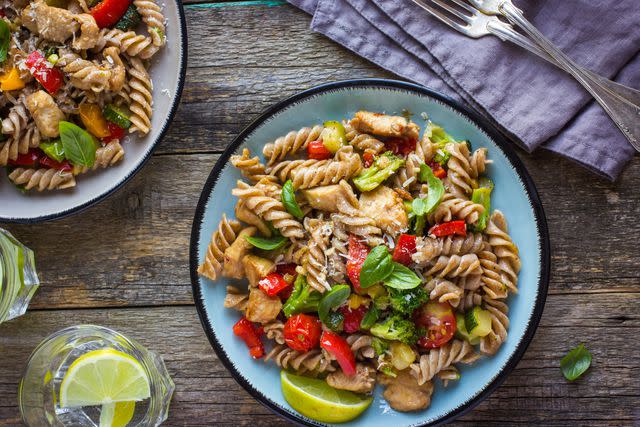
Anna Shepulova/Getty Images
What Is Whole-Wheat Pasta?
Whole-wheat pasta is any pasta made with whole wheat. Some pastas use a blend of whole wheat and refined flour, for a taste and texture that replicates traditional pasta.
“Whole-wheat pasta is crafted from whole wheat flour, and contains the entire wheat kernel—bran, germ, and endosperm,” explains Denise Hernandez, RD at MyFitnessPal. “Unlike refined white pasta, which lacks these elements, whole-wheat pasta preserves essential nutrients like fiber, B vitamins, magnesium, and iron. Its abundant fiber content fosters digestive well-being and a satisfying feeling of fullness.”
Whole-wheat pasta typically takes longer to cook than white pasta, because the grains take longer to soften. It’s important to watch the time when cooking whole-wheat pasta, however, as it can also more easily turn to mush.
Semolina vs. Whole-Wheat Pasta
Traditional pasta has a white or yellow-ish tint, while whole-wheat pasta is often tan or brown. Flavorwise, whole-wheat pasta can also taste a bit different.
“While it possesses a denser texture and nuttier flavor compared to white pasta, many value its unique flavor,” says Hernandez. “This nutritious alternative offers a wholesome option for those seeking to incorporate more whole grains into their diet, supporting overall well-being.”
While some may choose whole-wheat pasta based on flavor preference, nutrition can be a leading factor in opting for whole-wheat pasta. “Whole-wheat pasta is rich in dietary fiber, aids in digestion, and contains essential nutrients such as B vitamins [like folate, thiamine, and B6], magnesium, and iron, crucial for energy production and overall health,” says Hernandez. “The higher vitamin and mineral content in whole-wheat pasta contributes essential phytochemicals that may protect against some cancers.”
Typically, whole-wheat pasta will cost slightly more than traditional refined wheat pastas, but they’re reaping in health benefits.
Related: 8 Pasta Mistakes That Are Ruining Your Meal
Whole-Wheat Pasta Nutrition
Whole-wheat pasta is considered nutritious, more so than traditional pasta. “Depending on the brand, a whole-wheat pasta usually offers between six and seven grams of fiber, and six and eight grams of protein per serving,” says Victoria M. Smith, RDN, CDN, CEDS of Top Nutrition Coaching. “Dietary fiber is essential to gut health and the digestion process, attributing to satiety and fullness with eating.” Whole grains contain 25 percent more protein than their refined counterparts, according to the Whole Grains Council.
Additionally, whole-wheat pasta has a lower glycemic index than refined flour pasta, and can help manage blood sugar levels, adds Hernandez. “Overall, due to its rich nutrient content and well-rounded composition, whole-wheat pasta emerges as a nutritious option for those prioritizing health-conscious decisions,” she says.
And like any ingredient, there are ways to make eating and enjoying whole-wheat pasta even healthier. “Incorporating colorful, nutrient-rich vegetables like spinach, tomatoes, and bell peppers can increase vitamins and antioxidants,” says Hernandez. “Choosing lean protein sources like grilled chicken, fish, or legumes further boosts nutritional value as well.”
Whole-Wheat Pasta Recipes
Pretty much any pasta recipe can be made with whole-wheat pasta instead of traditional pasta. Here are a few whole-wheat pasta recipes to get you started.
Whole-Wheat Pasta With Chard and Pine Nuts
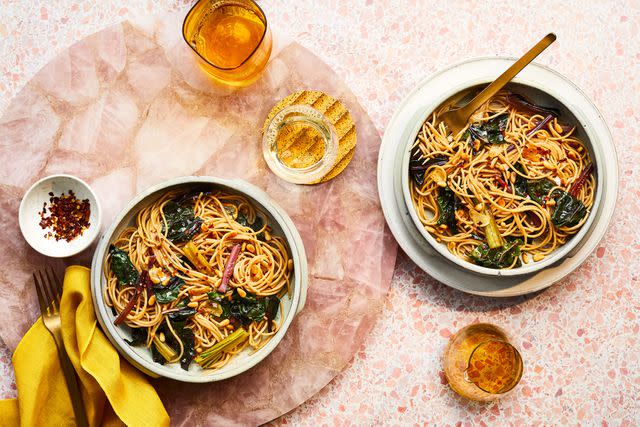
This seven-ingredient meal comes together in minutes, and it’s packed with flavor and nutrition. Whole-wheat pasta adds a nice nuttiness to the vegetarian dish that can easily become a weeknight staple year-round.
Whole-Grain Spaghetti With Kale and Tomatoes
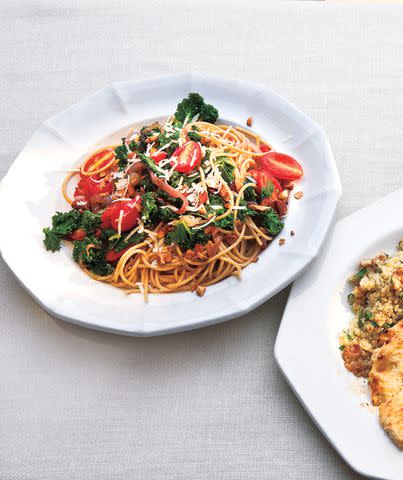
This healthy spaghetti recipe packs a punch, thanks to the super garlicky kale. Sautéed tomatoes add a nice saucy element to a one-pan dish that’s great for the whole family.
Whole-Wheat Penne With Feta and Arugula
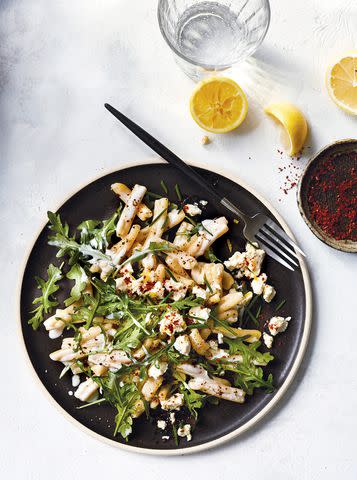
Rich flavor and nutrition meet in this simple pasta recipe that uses yogurt to add creaminess. And adding baby arugula on top of your pasta means it’s basically a salad.
Creamy Butternut Squash Pasta With Leeks
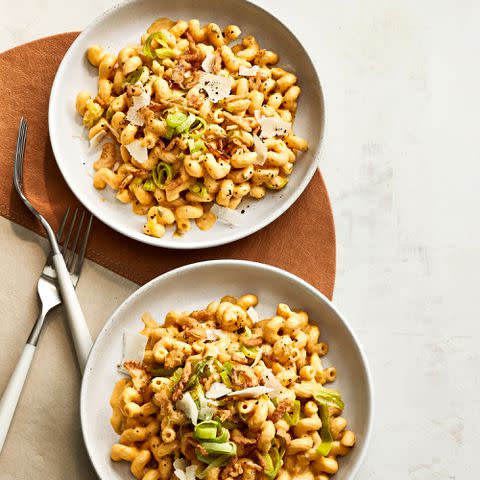
Whole-wheat pasta holds up well in creamy and baked pasta recipes, and adds a nice texture and rich taste to this squash-coated pasta. If you can’t find whole grain cavatappi, opt for another short shape, like rigatoni or fusilli.
Zucchini Pesto Pasta
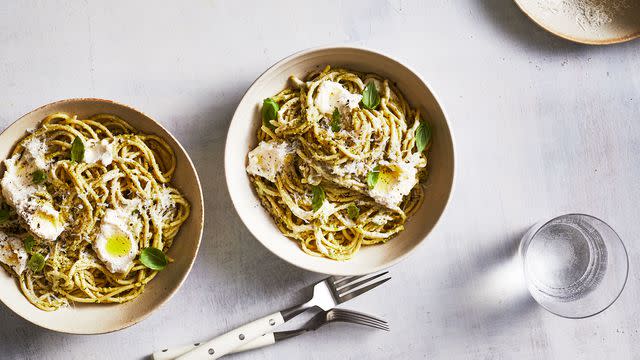
This homemade pesto puts a fun twist on a traditional pesto recipe, adding veggies and cashews for some silkiness. Mix it with any pasta to enjoy hot or cold.
Related: 9 Ways to Add More Protein to Your Favorite Pasta Dish—and Recipes to Get You Started
Frequently Asked Questions
Does whole-wheat pasta taste different from regular pasta?
If you’re used to semolina or white pasta, you may notice a difference in taste in whole-wheat pasta. However, whole-wheat pasta coated in flavorful sauce can be indistinguishable from other pastas.
Is whole-wheat pasta gluten-free?
No. Since whole-wheat pasta is also made with wheat, it contains gluten and is not gluten free.
For more Real Simple news, make sure to sign up for our newsletter!
Read the original article on Real Simple.

